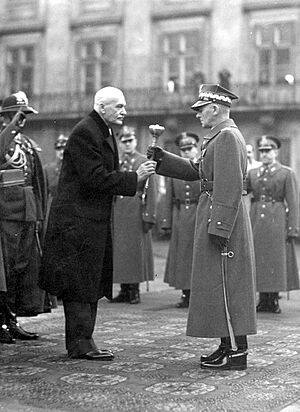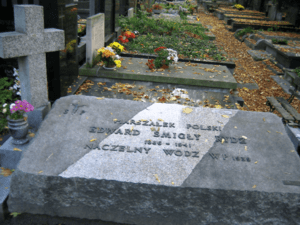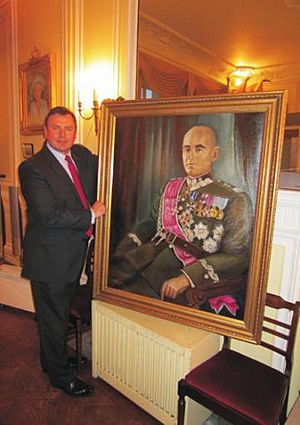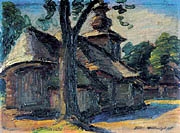Edward Rydz-Śmigły facts for kids
Quick facts for kids
Marshal of Poland
Edward Rydz-Śmigły
|
|
|---|---|

Rydz-Śmigły in 1937
|
|
| General Inspector of the Armed Forces | |
| In office 12 May 1935 – 7 November 1939 |
|
| President | Ignacy Mościcki |
| Preceded by | Józef Piłsudski |
| Succeeded by | Władysław Sikorski |
| Personal details | |
| Born | 11 March 1886 Brzeżany, Austria-Hungary (now Berezhany, Ternopil Oblast, Ukraine) |
| Died | 2 December 1941 (aged 55) Warsaw, occupied Poland |
| Awards | |
| Signature | |
| Nicknames | Adam Zawisza, Tarłowski |
| Military service | |
| Allegiance | |
| Branch/service | |
| Years of service | 1914–1939 |
| Rank | Marshal of Poland |
| Commands | C-i-C of the Polish Armed Forces |
| Battles/wars | First World War Polish-Ukrainian War Polish-Soviet War Second World War |
Marshal Edward Rydz-Śmigły (born March 11, 1886 – died December 2, 1941) was a very important Polish leader. He was a politician, a statesman, and a Marshal of Poland. He also served as the Commander-in-Chief of Poland's armed forces. Interestingly, he was also a talented painter and poet!
During the time between World War I and World War II, he was a highly respected public figure in Poland. People saw him as a hero because of his excellent record as an army commander. He led soldiers in the Polish Legions during World War I and in the Polish–Soviet War in 1920. After Marshal Józef Piłsudski passed away in 1935, Rydz-Śmigły became the Commander-in-Chief and Inspector General of the Polish Armed Forces. He held this important role when World War II began with the invasion of Poland.
When war seemed likely, political differences were set aside. Protecting the country became the most important goal. Because of this, Rydz-Śmigły's standing became even greater than the president's. The shock of Poland's defeat made it hard to judge his actions fairly. His reputation, closely linked to the start of World War II, is still a topic of discussion.
Contents
Early Life and Military Beginnings
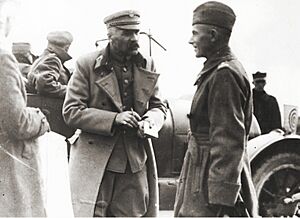
Edward Rydz was born in Brzeżany, a city in Galicia, which was part of Austria-Hungary at the time. His parents were Polish. His father, Tomasz Rydz, was a professional soldier. Edward grew up in humble surroundings and became an orphan at 13. He was then cared for by his grandparents and later by a doctor's family.
After finishing school with excellent grades, Rydz went to Kraków. He studied philosophy and art history at the Jagiellonian University. He also studied painting at the Academy of Fine Arts in Kraków, and later in Vienna and Munich. In 1910–1911, he attended a military academy in Vienna. He received military training with a famous Austrian infantry regiment.
Rydz finished his military training with high honors. He was offered a job in the Imperial Army, but he chose not to take it. In 1912, Rydz helped start a Polish military group called the Riflemen's Association. At the same time, he finished his art studies. He was seen as a very promising artist, especially in landscape and portrait painting. His teachers and art critics often praised his work.
Fighting for Poland's Freedom
In July 1914, Rydz joined the Austro-Hungarian Army. But in August, he moved to the Polish Legions. He fought in World War I alongside Józef Piłsudski's famous Polish 1st Brigade. He took part in many battles against the Russian Army and quickly moved up in rank. By 1916, he was already a full colonel. He even found time to show his artwork in a gallery in Kraków around this time.
In 1917, the Legions were disbanded after they refused to promise loyalty to the Austrian and German authorities. Their soldiers were held in camps, and their leader, Józef Piłsudski, was imprisoned. Piłsudski chose Rydz to become the commander of the Polish Military Organization (POW). Rydz, who was released from prison due to illness, adopted the nickname Śmigły (meaning "Fast" or "Agile"). He later added this name to his last name.
In October 1918, Rydz joined the government in Lublin as the Minister of War. He was promoted to brigadier general. He made it clear that he saw himself as Piłsudski's representative in this role. This is when he started using the name Rydz-Śmigły. On November 11, 1918, the government gave all power to Piłsudski, who became the temporary Head of State. Piłsudski confirmed Rydz-Śmigły as a brigadier general in the Polish army.
Military Victories and Leadership
During the Polish-Soviet War (1919–1921), Rydz-Śmigły led Polish armies in several attacks against the Soviet forces. He successfully captured cities like Wilno (Vilnius) and Dünaburg. After his victories, he was made Commander-in-Chief of the Latvian armed forces. He quickly helped free Latgale from the Soviet Army. He then defeated the Soviet 12th Army and took the city of Kiev.
When the Soviet forces counterattacked and reached the gates of Warsaw, Rydz-Śmigły commanded the Central Front of the Polish forces. This was during the Battle of Warsaw of 1920, also known as the "Miracle on the Vistula." In this very important battle, Rydz-Śmigły's forces held strong against the Soviet attack. They also blocked the escape routes for the defeated Soviet armies.
Becoming a Key Leader

After the Polish-Soviet war, Rydz-Śmigły became the Inspector General of the Polish Army. In 1926, during Piłsudski's May Coup, Rydz-Śmigły supported Piłsudski. He sent troops to help the anti-government forces in Warsaw. Piłsudski never forgot this loyalty. In 1929, Rydz-Śmigły was made Piłsudski's deputy for all matters concerning the East.
On May 13, 1935, after Piłsudski's death, Rydz-Śmigły was chosen by the president and government to be the Inspector-General of the Polish Armed Forces. This was the highest military position in Poland. It was done according to Piłsudski's wishes. After Piłsudski's death, his followers were divided. President Ignacy Mościcki and Rydz-Śmigły eventually made an agreement to share power. This meant Rydz-Śmigły became the main leader of Poland until the war began, while Mościcki remained president.
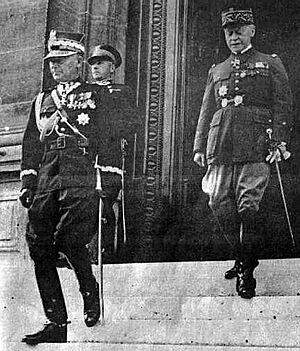
From 1935, Rydz-Śmigły quickly gained more power and higher positions. On July 15, 1936, the Polish prime minister officially called him the "Second Man in the State after the President." On November 10, he was promoted to the rank of Marshal of Poland. A movement called "Ozon" tried to make Rydz-Śmigły seem like Piłsudski's chosen successor. However, this upset many of Piłsudski's supporters.
The time when Rydz-Śmigły was in charge (1935–1939) is sometimes called "a leadership without a single strong leader." Rydz-Śmigły did not have the same strong influence as Piłsudski. The ruling group was divided between those supporting President Mościcki and those supporting Rydz-Śmigły. The government became more controlling, but it never gained wide public support.
World War II and the Invasion of Poland
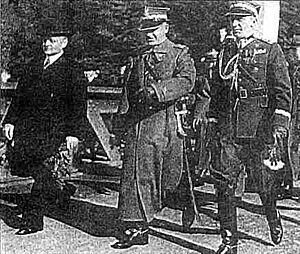
In March 1939, Adolf Hitler divided Czechoslovakia. This meant Poland was surrounded by Germany and its allies on almost all sides. Rydz-Śmigły was one of the few government members who saw the danger of a conflict with Germany. However, there was not enough time to prepare a new army plan for the west. In August 1939, during talks in Moscow, Rydz-Śmigły refused to let the Soviet Army march through Poland. He believed the Soviets might not truly help and would never leave Polish land once they entered.
On September 1, 1939, the Germans invaded Poland. Rydz-Śmigły was named Commander-in-Chief of all Polish forces. On September 7, he and most of the government left Warsaw as it was being attacked. Polish communication equipment had problems, which made it hard for Rydz-Śmigły to command his forces. In Brest, on September 11, he ordered Warsaw to be defended at all costs. His plan was for Warsaw and Modlin Fortress to hold out as long as possible. The main Polish forces would defend a "Romanian bridgehead" and wait for help from France and Britain.
However, the Western Allies did not have such a plan and expected Poland to fall. This strategy was further ruined when Soviet forces invaded Poland from the east on September 17. Rydz-Śmigły realized that fighting both Germany and the Soviet Union was impossible. He ordered his forces to retreat towards Romania and not to fight the Soviet attackers.
On September 18, 1939, Rydz-Śmigły escaped to Romania. He was then held there. The Polish government's move into Romania meant Poland did not have to officially surrender. This allowed Polish soldiers to continue fighting against Nazi Germany. Many Polish soldiers and airmen managed to escape through Romania to southern Europe. They later regrouped in France, and then in the UK after France surrendered.
Later Life and Legacy
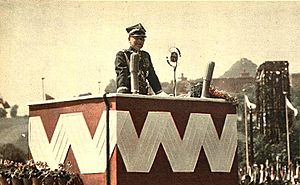
As the Commander-in-Chief, Rydz-Śmigły took full responsibility for Poland's military defeat in September 1939. He had been a very skilled commander in smaller wars. However, he was not an experienced leader for a large-scale conflict. Even Piłsudski had once said that Rydz-Śmigły was good for commanding an army, but he wasn't sure if he could lead a country in a major war.
While held in Romania, Rydz-Śmigły started creating a Polish underground movement. This group was made of officers loyal to Piłsudski. On October 27, he gave up his role as Commander-in-Chief. This role was taken by Władysław Sikorski, who was part of the new Polish government-in-exile in France.
Rydz-Śmigły escaped from Romania on December 10, 1940, and went to Hungary. His escape and rumors of his return to Poland worried his rival, Sikorski, who was now Prime Minister. Sikorski told the leader of the Polish underground, General Stefan Grot-Rowecki, that Rydz-Śmigły's presence in Poland would harm their work. Sikorski wanted him to go to a country in the British Empire.
However, Rydz-Śmigły left Hungary on October 25, 1941. He traveled through Slovakia and secretly returned to Warsaw on October 30. He wanted to join the resistance movement as a regular soldier, giving up his rank as Marshal. He managed to contact Grot-Rowecki but kept his identity a secret. He sadly died suddenly of heart failure on December 2, 1941, at age 55. This was only five weeks after he arrived in Warsaw.
He was buried in Warsaw under his nickname "Adam Zawisza." His tombstone at the Powązki Cemetery had this name until 1991. In 1994, the people of Warsaw placed a new tombstone with his full name on his grave. Rydz-Śmigły was married to Marta Zaleska, but they did not have any children.
Rydz-Śmigły's Legacy
After World War II, Edward Rydz-Śmigły's reputation was generally not good. In the Soviet Union and other Eastern European countries, he was criticized for his role in the Polish-Soviet War and for his part in Poland's defeat in 1939. In Western countries, some people believed he had fled the battlefield in 1939. They often did not fully understand the impossible situation Poland faced when invaded by both Germany and the Soviet Union.
In 2016, a large oil painting of Edward Rydz-Śmigły was found in the archives of The Sikorski Museum in London. It had been folded and hidden in a briefcase to protect it from the Nazi occupation forces. A private member of The Polish Heritage Society, Philip Bujak, funded its restoration. The restored painting was then given back to the Sikorski Institute, where it is now on display.
Awards and Honors
Polish Awards Edward Rydz-Śmigły received many important Polish awards. These include the Order of the White Eagle, the Commander and Knight of Virtuti Militari, and the Grand Cross of the Order of Polonia Restituta. He also earned the Cross of Valour four times, the Golden Cross of Merit, and the Cross of Independence with Swords.
Foreign Awards He also received many awards from other countries. These include the Grand Cross of the Order of the Star of Romania, the Grand Cross of the Order of the Crown of Italy, and the Grand Officer of the French Legion of Honour. Other awards include the Grand Officer of the Finnish Order of the White Rose, the Grand Cross of the Order of the White Eagle and Order of Saint Sava of Yugoslavia, and the Grand Cross of the Hungarian Order of Merit. He also received the Grand Cross of the Japanese Order of the Rising Sun, Latvia's highest military award (the Order of Lāčplēsis), the Pulaski Medal from the USA, and the Italian Cross of Military Merit.
Special Titles Rydz-Śmigły was given honorary doctorates from the Universities of Warsaw and Vilnius, and the Warsaw University of Technology. He was also made an Honorary Citizen of several Polish cities.
Tributes The Marshal Edward Śmigły-Rydz Park is a large public park in Warsaw. It was created after World War II and is located near the Polish parliament building.
Works by Rydz-Śmigły
- On military topics:
- Walka na bagnety (Bayonet Fight), 1914
- W sprawie polskiej doktryny (Poland's Military Doctrine), 1924
- Kawaleria w osłonie (Cavalry Protecting Troops), 1925
- Byście o sile nie zapomnieli -Rozkazy, Artykuły, Mowy (Do Not Forget the Might – Orders, Articles and Speeches), 1936
- Wojna polsko-niemiecka (The Polish-German War), 1941
- Poetry:
- Dążąc do końca swoich dróg (Toward My Path's End), published in 1947 and 1989.
- Paintings and Drawings:
- He created illustrations for Piłsudski's book 22 January 1863 in 1920.
- He showed his art at exhibitions in Kraków (1916) and Warsaw (1917). Sadly, most of his paintings are now lost.
See also
 In Spanish: Edward Rydz-Śmigły para niños
In Spanish: Edward Rydz-Śmigły para niños
- Coat of arms of Ryc
Images for kids
-
Pre-war stamp featuring Marshal Rydz-Śmigły


